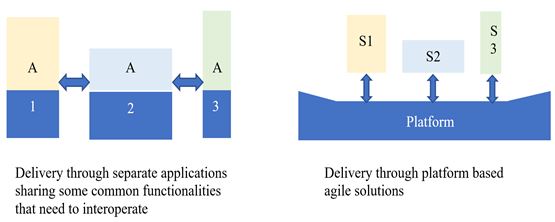City Platforms are a key part of any city architecture and cities and communities will each have a variety of different platforms at different layers of their overall city platform.
The logic behind the use of platforms is straightforward – instead of using many separate applications containing duplicating functionally, all common functionalities can be collected into a platform and solutions which are built on top of that platform then only need to possess unique functionality. The platform simplifies the use of its platform components and ensures interaction between them. Thus, the platform frees up resources to focus on solving unique problems.
The planning of new solutions can be coordinated within the scope of the platform to minimize duplication of efforts in solving the same problems. New solutions can be gradually included in the platform for widespread use. All interactions between the platform and applications can use standardized interfaces (API methodology).
Any city will have many, many existing platforms used by different organizations or departments and with various types of functions. They may be horizontal platforms such as IoT platforms, data platforms, AI platforms, etc., or they may be platforms focused on delivering a specific set of services such as smart mobility platforms, energy management platforms and so on. The key challenge is that these platforms are often built within silos, and it can be very difficult to share and manage data between them.

A city platform architecture does not consist of a massively complex set of software and hardware but rather a federation of many city platforms that work together seamlessly to help manage the city services in a holistic and effective way. Cities and communities will not need to develop such a platform all at once but rather can use the opportunity of new smart initiatives to develop the relevant parts of that platform in a modular fashion. What is important is that each platform that is developed to meet the needs of a specific initiative is also designed to fit within an overall common framework so that it can become an integral part of the developing smart city platform.
In short in order to build a city platform, the city needs to:
- Integrate existing platforms so that they can work well together;
- Make sure that new platforms developed to meet some specific priorities are built in a modular way to enable these new platforms to build towards the overall comprehensive smart city platform.
To do this, they need to put in place a platform architecture that can act as a blueprint for the work of integration.
Comments ()